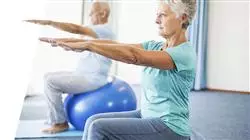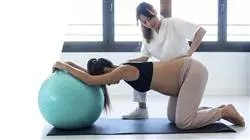University certificate
The world's largest faculty of physiotherapy”
Introduction to the Program
Thanks to this Professional master’s degree, the professional will obtain an up-to-date knowledge of Therapeutic Yoga taught by specialized professionals”

Scientific research has revealed the importance of the practice of Therapeutic Yoga for the reduction of cortisol, stress generator, or the segregation of endorphins that benefits the patient with anxiety. Likewise, the improvement of body posture produces positive effects in patients with diseases that especially affect the locomotor system.
The advances that have been achieved with the practice of Yoga have led to more and more professionals who are committed to its application in certain patients achieving improvements in their pathologies and creating healthy habits. In this scenario, it is the physiotherapists themselves who demand a continuous updating of their knowledge in order to achieve optimal results in their therapies. This Professional master’s degree provides the physiotherapist with extensive knowledge in this field thanks to the didactic material developed by a specialized teaching team.
Therefore, the professional can benefit from a program that presents a theoretical approach, but gives great relevance to practice. For this reason, a complete module is dedicated to the clinical approach through case studies in patients with frequent pathologies and incorporates Masterclasses of an internationally renowned teacher in this sector, which will lead you to integrate the main advances, techniques, exercise programs and developments in this discipline.
In addition, this Professional master’s degree also includes the participation of an internationally renowned teacher in the field of Therapeutic Yoga. Through a series of exclusive Masterclasses, physiotherapists will have the opportunity to access the latest developments in topics such as the neurophysiological bases of meditative techniques, the application of asana techniques and their integration, and the most common pathologies treated in Therapeutic Yoga. All this, taught by one of the most prominent figures in this field, which guarantees a learning experience of international quality.
TECH offers an excellent opportunity for those who wish to keep up to date with Therapeutic Yoga through a flexible university program that is compatible with the most demanding responsibilities. Students only need an electronic device to connect to the Virtual Campus. In this way, without on-site attendance or classes with fixed schedules, the graduate will be able to distribute the teaching load according to their needs.
You have a series of distinguished Masterclasses taught by an internationally renowned Therapeutic Yoga professional”
This Professional master’s degree in Therapeutic Yoga contains the most complete and up-to-date scientific program on the market. The most important features include:
- Case studies presented by Yoga experts
- The graphic, schematic, and practical contents with which they are created, provide scientific and practical information on the disciplines that are essential for professional practice
- Practical exercises where self-assessment can be used to improve learning
- Its special emphasis on innovative methodologies
- Theoretical lessons, questions to the expert, debate forums on controversial topics, and individual reflection assignments
- Content that is accessible from any fixed or portable device with an Internet connection
A university program that gives you the opportunity to keep up to date with the studies that address respiratory techniques and their benefits”
The program’s teaching staff includes professionals from the field who contribute their work experience to this educational program, as well as renowned specialists from leading societies and prestigious universities.
The multimedia content, developed with the latest educational technology, will provide the professional with situated and contextual learning, i.e., a simulated environment that will provide immersive education programmed to learn in real situations.
This program is designed around Problem-Based Learning, whereby the professional must try to solve the different professional practice situations that arise during the academic year For this purpose, the students will be assisted by an innovative interactive video system created by renowned and experienced experts.
This is a 100% online program that is flexible and compatible with your professional and personal work”

With innovative didactic resources, it delves into the theoretical and practical knowledge necessary for postural evaluation and articular and myofascial chains”
Why study at TECH?
TECH is the world’s largest online university. With an impressive catalog of more than 14,000 university programs available in 11 languages, it is positioned as a leader in employability, with a 99% job placement rate. In addition, it relies on an enormous faculty of more than 6,000 professors of the highest international renown.

Study at the world's largest online university and guarantee your professional success. The future starts at TECH”
The world’s best online university according to FORBES
The prestigious Forbes magazine, specialized in business and finance, has highlighted TECH as “the world's best online university” This is what they have recently stated in an article in their digital edition in which they echo the success story of this institution, “thanks to the academic offer it provides, the selection of its teaching staff, and an innovative learning method aimed at educating the professionals of the future”
A revolutionary study method, a cutting-edge faculty and a practical focus: the key to TECH's success.
The most complete study plans on the university scene
TECH offers the most complete study plans on the university scene, with syllabuses that cover fundamental concepts and, at the same time, the main scientific advances in their specific scientific areas. In addition, these programs are continuously being updated to guarantee students the academic vanguard and the most in-demand professional skills. In this way, the university's qualifications provide its graduates with a significant advantage to propel their careers to success.
TECH offers the most comprehensive and intensive study plans on the current university scene.
A world-class teaching staff
TECH's teaching staff is made up of more than 6,000 professors with the highest international recognition. Professors, researchers and top executives of multinational companies, including Isaiah Covington, performance coach of the Boston Celtics; Magda Romanska, principal investigator at Harvard MetaLAB; Ignacio Wistumba, chairman of the department of translational molecular pathology at MD Anderson Cancer Center; and D.W. Pine, creative director of TIME magazine, among others.
Internationally renowned experts, specialized in different branches of Health, Technology, Communication and Business, form part of the TECH faculty.
A unique learning method
TECH is the first university to use Relearning in all its programs. It is the best online learning methodology, accredited with international teaching quality certifications, provided by prestigious educational agencies. In addition, this disruptive educational model is complemented with the “Case Method”, thereby setting up a unique online teaching strategy. Innovative teaching resources are also implemented, including detailed videos, infographics and interactive summaries.
TECH combines Relearning and the Case Method in all its university programs to guarantee excellent theoretical and practical learning, studying whenever and wherever you want.
The world's largest online university
TECH is the world’s largest online university. We are the largest educational institution, with the best and widest online educational catalog, one hundred percent online and covering the vast majority of areas of knowledge. We offer a large selection of our own degrees and accredited online undergraduate and postgraduate degrees. In total, more than 14,000 university degrees, in eleven different languages, make us the largest educational largest in the world.
TECH has the world's most extensive catalog of academic and official programs, available in more than 11 languages.
Google Premier Partner
The American technology giant has awarded TECH the Google Google Premier Partner badge. This award, which is only available to 3% of the world's companies, highlights the efficient, flexible and tailored experience that this university provides to students. The recognition as a Google Premier Partner not only accredits the maximum rigor, performance and investment in TECH's digital infrastructures, but also places this university as one of the world's leading technology companies.
Google has positioned TECH in the top 3% of the world's most important technology companies by awarding it its Google Premier Partner badge.
The official online university of the NBA
TECH is the official online university of the NBA. Thanks to our agreement with the biggest league in basketball, we offer our students exclusive university programs, as well as a wide variety of educational resources focused on the business of the league and other areas of the sports industry. Each program is made up of a uniquely designed syllabus and features exceptional guest hosts: professionals with a distinguished sports background who will offer their expertise on the most relevant topics.
TECH has been selected by the NBA, the world's top basketball league, as its official online university.
The top-rated university by its students
Students have positioned TECH as the world's top-rated university on the main review websites, with a highest rating of 4.9 out of 5, obtained from more than 1,000 reviews. These results consolidate TECH as the benchmark university institution at an international level, reflecting the excellence and positive impact of its educational model.” reflecting the excellence and positive impact of its educational model.”
TECH is the world’s top-rated university by its students.
Leaders in employability
TECH has managed to become the leading university in employability. 99% of its students obtain jobs in the academic field they have studied, within one year of completing any of the university's programs. A similar number achieve immediate career enhancement. All this thanks to a study methodology that bases its effectiveness on the acquisition of practical skills, which are absolutely necessary for professional development.
99% of TECH graduates find a job within a year of completing their studies.
Professional Master's Degree in Yoga Therapy
Professionals dedicated to the physical therapy sector are constantly updating their knowledge in order to provide the most innovative and practical treatments to their patients. To help fulfill this purpose, at TECH we designed a Professional Master's Degree in Yoga Therapy. A program of the highest academic quality focused on providing the necessary tools to acquire anatomical and physiological knowledge of the body by adapting the discipline according to the biomechanical and pathological characteristics of the patients treated. You will become an expert in treating topics such as kinesitherapy, the application of integrated asana techniques and diagnostic assessment of counseling. Highlight your career and incorporate new skills to your professional profile in the largest School of Physiotherapy.
Take a Professional Master's Degree 100% online
At TECH we offer you the most innovative online teaching methodology on the market, which allows you to develop your course at the time and schedule that best suits you. You will enhance your skills to achieve optimal results when recommending therapeutic treatments, thus, you will improve the quality of life of the people treated. Throughout 1,500 hours you will learn in depth about the clinical approach of this therapy, including yoga in the different evolutionary moments, the neurophysiology of brain activity and the kinesiological and neurophysiological bases focused on relaxation and meditation. In addition, you will gain the necessary knowledge to perform a proper praxis based on the latest scientific technology.
Study a postgraduate degree in yoga and therapy
Physiotherapists who wish to include new competencies to their professional profile and increase their employability opportunities will find in TECH a program with academic excellence. We have a team of highly trained experts who will impart their knowledge and experience to provide added value to the curriculum. In addition, we offer you a completely updated set of global and scientific information. At the end of this program you will be fully trained to treat patients with muscle tension who present abnormalities and asymmetries in bone alignment. All this through the use of meditation techniques, exercises and hygienic-health advice developed from an initial diagnosis.







